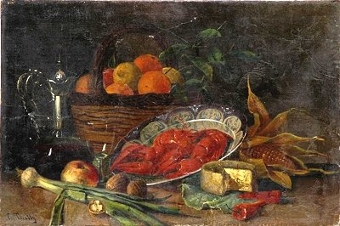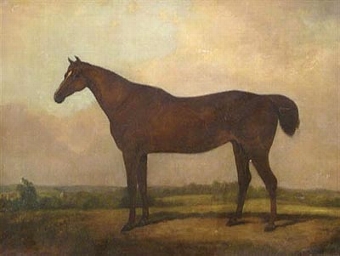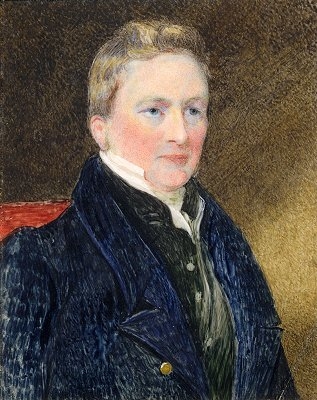Colombo (1931?1954) was a British Thoroughbred racehorse and sire. In a career that lasted from April 1933 to June 1934 he ran eleven times and won nine races. Colombo was an outstanding two-year-old, unbeaten in seven races in 1933 and drawing comparisons with champions such as Isinglass, Persimmon and Bayardo. In 1934 he maintained his unbeaten record by winning the Craven Stakes and the 2000 Guineas at Newmarket and then finished third as the favourite in the Epsom Derby. After one more unsuccessful race he was retired to stud, where he had some success as a sire of winners until his death in 1954.
Colombo, a large, powerful, lop-eared horse with a "raking, effortless stride" was bred by the shipping magnate Sir Alec Black. He was bay with a white star, a white sock on his left foreleg and a white coronet on his right hind leg. Shortly after Colombo was foaled, Black decided to sell off his bloodstock and the colt was bought relatively cheaply for 510 guineas by Lord Glanely at Doncaster in 1932. Colombo was sired by Manna, the winner of the 2000 Guineas and the Epsom Derby, out of Lady Nairne, a mare who was also bought by Glanely at another one of Black''s dispersal sales. Lady Nairne failed to win a race, but had a good pedigree, being a sister of the 2000 Guineas winner Ellangowan. Glanely sent Colombo to his private trainer, Captain Thomas Hogg at Newmarket, Suffolk.
The horse who would become known as Colombo began his racing career as an unnamed "Colt by Manna-Lady Nairne" at Newmarket in April, winning the Spring Stakes by a head from the future 1000 Guineas winner Campanula.] He appeared as Colombo for the first time on May 17 when he won the Scarborough Stakes at York. In June he was sent to Royal Ascot where he won the New Stakes, the race now known as the Norfolk Stakes, and then added the Fulbourne Stakes at Newmarket two weeks later. In July Colombo won the valuable National Breeders'' Produce Stakes at Sandown "in a canter" from the filly Silver Araby. At Goodwood later that month he moved up to six furlongs for the first time in the Richmond Stakes in which he was matched against the season''s other leading colt, the Coventry Stakes winner Medieval Knight. Ridden by the ten-times Champion Jockey Steve Donoghue, Colombo went to the front after a furlong and was never in any danger of defeat, beating Medieval Knight by three lengths and proving himself "vastly superior" to the opposition.
On his final start of the year he ran in the Imperial Produce Stakes at Kempton which he won in course record time by a short head from Valerius, to whom he was conceding seventeen pounds. Donoghue rode with exaggerated confidence, never resorting to the whip even when closely pressed in the final strides. Glanely was dissatisfied with Donoghue''s performance and recruited the Australian rider Rae Johnstone to partner his horse in the following year''s Classics. The press however, were highly impressed, and reports described Colombo as "one of the century''s wonder horses" and "a perfect racing machine". The Sporting Life described him as the most impressive two-year-old since The Tetrarch and expressed the belief that his pedigree would enable him to be equally effective over longer distances in 1934 Colombo''s earnings of ?17,130 made him the second most successful juvenile in British racing history behind Orwell.
In the Free Handicap, a ranking of the season''s best two-year-olds, Colombo was rated the best horse of his generation by a record margin of seven pounds.
Reports early in 1934 suggested that Colombo had made good progress over the winter and was performing impressively in trial gallops. On his three-year-old debut at Newmarket on 19 April, Colombo was ridden by Johnstone for the first time in public and successfully moved up to one mile by winning the Craven Stakes "in a canter" by four lengths from the Aga Khan''s colt Osman Pasha, who was carrying twenty pounds less than the winner. Both his physical appearance and manner of victory were highly praised by observers including the Sporting Life''s correspondent. Johnstone''s riding was closely scrutinised, especially by those who felt that his undoubted strength and successes in Australia and France were outweighed by his lack of British experience. Colombo then ran in the 2000 Guineas over the same course and distance two weeks later. Ridden by Johnstone, he started at odds of 2/7 against twelve opponents, making him the shortest-priced favourite since St. Frusquin in 1896. He won by a length from Easton, with Badruddin one and a half lengths further back in third.
A month later, Colombo moved up in distance to one and a half miles, and started 11/8 favourite for the Epsom Derby. Opinion before the race held that if he stayed the distance, the Derby was "all over", although it was also pointed out that several brilliant Guineas winners had failed at Epsom. The race proved to be a controversial one. Approaching the straight, Johnstone found himself boxed in against the rails, and was then forced to drop back when the horse in front of him (Medieval Knight, ridden by Steve Donoghue) weakened. He was forced to pull Colombo to the wide outside to make his challenge, by which time Windsor Lad had taken a decisive advantage. He finished strongly and finished third, one length and a neck behind Windsor Lad and Easton. Johnstone was criticised for his performance, with Donoghue in particular, making no secret of his belief that he would have won the race if he had been allowed to keep the ride. Glanely stopped using Johnstone on his horses shortly afterwards. Other observers however, felt that Johnstone had given the colt every chance to win in the straight, and that his defeat was attributable to lack of stamina, which had left him unable to use his speed in the closing stages.
Colombo''s only subsequent race was the St. James''s Palace Stakes at Royal Ascot in which he returned to the one mile distance. He started favourite at odds of 1/5, failed to catch the front-running Flamenco and was beaten by half a length in what was described as "a catastrophe for the backers", who had wagered on the colt as if defeat were out of the question. He was being trained for the St Leger but sustained a knee injury and was retired to stud.
Colombo stood as a stallion at his owner''s stud at Exning.] He sired two classic winners in Happy Knight (2000 Guineas) and Dancing Time (1000 Guineas).
William James Tatem, 1st Baron Glanely (6 March 1868 ? 28 June 1942), known as Sir William Tatem, Bt, between 1916 and 1918, was a Cardiff ship-owner and thoroughbred racehorse owner and breeder. Tatem was born in Appledore, North Devon from where he originally went to sea. He moved to Cardiff at the age of 18 and began work at the shipping offices of Anning Brothers. In 1897 he founded the Lady Lewis Steamship Company with a ship of that name and in 1910 this became the Tatem Steam Ship Company. He was a benefactor of Cardiff University Cardiff and donated the money to build the 1904 Chemistry and Physics block. He was created a Baronet in 1916 and raised to the peerage as Baron Glanely, of St. Fagans in the County of Glamorgan, in 1918. During the Spanish Civil War Glanely was part of widespread Welsh support for the Spanish Republic. In 1937 he helped the National Joint Committee for Spanish Relief to open a home at Cambria House, Caerleon for 50 Basque child refugees.] He let the Basque Government charter his two oldest steamships, SS Molton and SS Pilton, to bring Republican refugees out of the Republican-held part of northern Spain, which was encircled by insurgent forces. On 14 July Molton tried to enter Republican-held Santander but the insurgent cruiser Almirante Cervera captured her and an insurgent armed trawler took Molton to Bilbao, which by then had fallen to the insurgents. Pilton was more successful, firstly carrying many refugees out of Santander, and then on 27 July 1937 bringing refugees from Avil?s to France.
In the interwar period he was one of the leading owners in British flat racing. He bought the Lagrange stables at Newmarket in 1919 and maintained it until it was requisitioned by the British Army in 1939. He was British flat racing Champion Owner in 1919 and 1941, and was elected to the Jockey Club in 1929. His racing colours were black jacket, red, white and blue belt and cap.
His horses won six British Classic Races:
Epsom Derby - Grand Parade (1919)
Epsom Oaks - Rose of England (1930)
2,000 Guineas - Colombo (1934)
1,000 Guineas - Dancing Time (1941)
St. Leger - Singapore (1930), Chulmleigh, (1937)
Lord Glanely was killed in an air-raid in Weston-super-Mare in 1942, aged 74, when his titles became extinct.
Antiques.co.uk Ref: 42RJB4G4
- Materials:
- Oil on Canvas
- Width (cm):
- 14 x 17in. 36 x 43 cm.












